Yeon-Chang Lee
CAPER: Enhancing Career Trajectory Prediction using Temporal Knowledge Graph and Ternary Relationship
Aug 28, 2024



Abstract:The problem of career trajectory prediction (CTP) aims to predict one's future employer or job position. While several CTP methods have been developed for this problem, we posit that none of these methods (1) jointly considers the mutual ternary dependency between three key units (i.e., user, position, and company) of a career and (2) captures the characteristic shifts of key units in career over time, leading to an inaccurate understanding of the job movement patterns in the labor market. To address the above challenges, we propose a novel solution, named as CAPER, that solves the challenges via sophisticated temporal knowledge graph (TKG) modeling. It enables the utilization of a graph-structured knowledge base with rich expressiveness, effectively preserving the changes in job movement patterns. Furthermore, we devise an extrapolated career reasoning task on TKG for a realistic evaluation. The experiments on a real-world career trajectory dataset demonstrate that CAPER consistently and significantly outperforms four baselines, two recent TKG reasoning methods, and five state-of-the-art CTP methods in predicting one's future companies and positions-i.e., on average, yielding 6.80% and 34.58% more accurate predictions, respectively.
Disentangling, Amplifying, and Debiasing: Learning Disentangled Representations for Fair Graph Neural Networks
Aug 23, 2024Abstract:Graph Neural Networks (GNNs) have become essential tools for graph representation learning in various domains, such as social media and healthcare. However, they often suffer from fairness issues due to inherent biases in node attributes and graph structure, leading to unfair predictions. To address these challenges, we propose a novel GNN framework, DAB-GNN, that Disentangles, Amplifies, and deBiases attribute, structure, and potential biases in the GNN mechanism. DAB-GNN employs a disentanglement and amplification module that isolates and amplifies each type of bias through specialized disentanglers, followed by a debiasing module that minimizes the distance between subgroup distributions to ensure fairness. Extensive experiments on five datasets demonstrate that DAB-GNN significantly outperforms ten state-of-the-art competitors in terms of achieving an optimal balance between accuracy and fairness.
Empowering Interdisciplinary Insights with Dynamic Graph Embedding Trajectories
Jun 25, 2024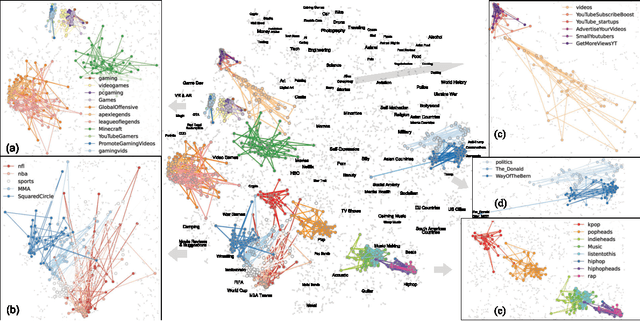
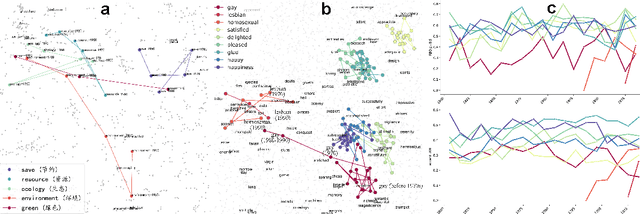

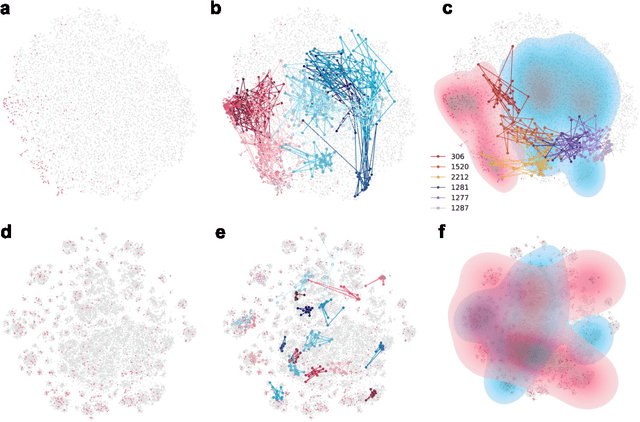
Abstract:We developed DyGETViz, a novel framework for effectively visualizing dynamic graphs (DGs) that are ubiquitous across diverse real-world systems. This framework leverages recent advancements in discrete-time dynamic graph (DTDG) models to adeptly handle the temporal dynamics inherent in dynamic graphs. DyGETViz effectively captures both micro- and macro-level structural shifts within these graphs, offering a robust method for representing complex and massive dynamic graphs. The application of DyGETViz extends to a diverse array of domains, including ethology, epidemiology, finance, genetics, linguistics, communication studies, social studies, and international relations. Through its implementation, DyGETViz has revealed or confirmed various critical insights. These include the diversity of content sharing patterns and the degree of specialization within online communities, the chronological evolution of lexicons across decades, and the distinct trajectories exhibited by aging-related and non-related genes. Importantly, DyGETViz enhances the accessibility of scientific findings to non-domain experts by simplifying the complexities of dynamic graphs. Our framework is released as an open-source Python package for use across diverse disciplines. Our work not only addresses the ongoing challenges in visualizing and analyzing DTDG models but also establishes a foundational framework for future investigations into dynamic graph representation and analysis across various disciplines.
SVD-AE: Simple Autoencoders for Collaborative Filtering
May 08, 2024Abstract:Collaborative filtering (CF) methods for recommendation systems have been extensively researched, ranging from matrix factorization and autoencoder-based to graph filtering-based methods. Recently, lightweight methods that require almost no training have been recently proposed to reduce overall computation. However, existing methods still have room to improve the trade-offs among accuracy, efficiency, and robustness. In particular, there are no well-designed closed-form studies for \emph{balanced} CF in terms of the aforementioned trade-offs. In this paper, we design SVD-AE, a simple yet effective singular vector decomposition (SVD)-based linear autoencoder, whose closed-form solution can be defined based on SVD for CF. SVD-AE does not require iterative training processes as its closed-form solution can be calculated at once. Furthermore, given the noisy nature of the rating matrix, we explore the robustness against such noisy interactions of existing CF methods and our SVD-AE. As a result, we demonstrate that our simple design choice based on truncated SVD can be used to strengthen the noise robustness of the recommendation while improving efficiency. Code is available at https://github.com/seoyoungh/svd-ae.
Towards Fair Graph Anomaly Detection: Problem, New Datasets, and Evaluation
Feb 25, 2024



Abstract:The Fair Graph Anomaly Detection (FairGAD) problem aims to accurately detect anomalous nodes in an input graph while ensuring fairness and avoiding biased predictions against individuals from sensitive subgroups such as gender or political leanings. Fairness in graphs is particularly crucial in anomaly detection areas such as misinformation detection in search/ranking systems, where decision outcomes can significantly affect individuals. However, the current literature does not comprehensively discuss this problem, nor does it provide realistic datasets that encompass actual graph structures, anomaly labels, and sensitive attributes for research in FairGAD. To bridge this gap, we introduce a formal definition of the FairGAD problem and present two novel graph datasets constructed from the globally prominent social media platforms Reddit and Twitter. These datasets comprise 1.2 million and 400,000 edges associated with 9,000 and 47,000 nodes, respectively, and leverage political leanings as sensitive attributes and misinformation spreaders as anomaly labels. We demonstrate that our FairGAD datasets significantly differ from the synthetic datasets used currently by the research community. These new datasets offer significant values for FairGAD by providing realistic data that captures the intricacies of social networks. Using our datasets, we investigate the performance-fairness trade-off in eleven existing GAD and non-graph AD methods on five state-of-the-art fairness methods, which sheds light on their effectiveness and limitations in addressing the FairGAD problem.
Trustworthiness-Driven Graph Convolutional Networks for Signed Network Embedding
Sep 02, 2023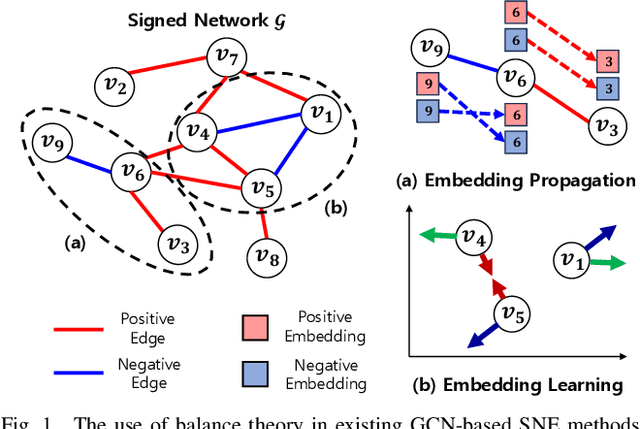


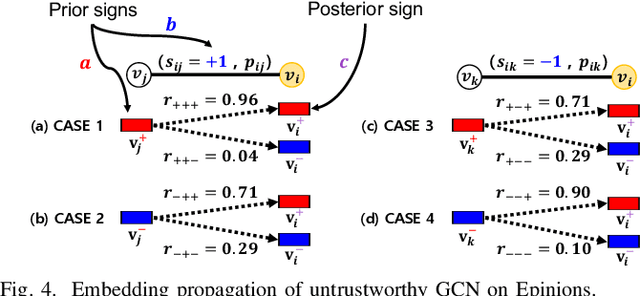
Abstract:The problem of representing nodes in a signed network as low-dimensional vectors, known as signed network embedding (SNE), has garnered considerable attention in recent years. While several SNE methods based on graph convolutional networks (GCN) have been proposed for this problem, we point out that they significantly rely on the assumption that the decades-old balance theory always holds in the real-world. To address this limitation, we propose a novel GCN-based SNE approach, named as TrustSGCN, which corrects for incorrect embedding propagation in GCN by utilizing the trustworthiness on edge signs for high-order relationships inferred by the balance theory. The proposed approach consists of three modules: (M1) generation of each node's extended ego-network; (M2) measurement of trustworthiness on edge signs; and (M3) trustworthiness-aware propagation of embeddings. Furthermore, TrustSGCN learns the node embeddings by leveraging two well-known societal theories, i.e., balance and status. The experiments on four real-world signed network datasets demonstrate that TrustSGCN consistently outperforms five state-of-the-art GCN-based SNE methods. The code is available at https://github.com/kmj0792/TrustSGCN.
A Survey of Graph Neural Networks for Social Recommender Systems
Dec 12, 2022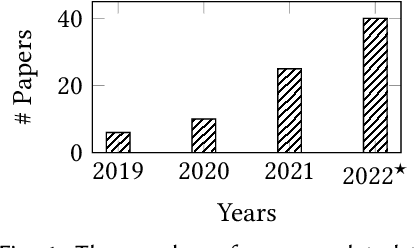
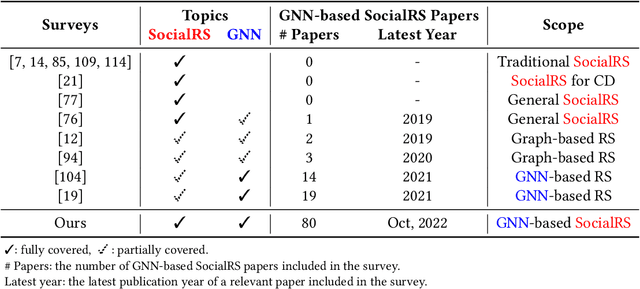
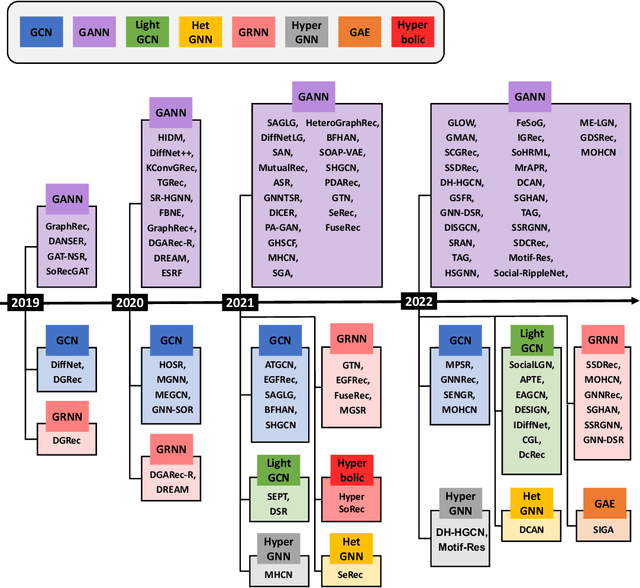
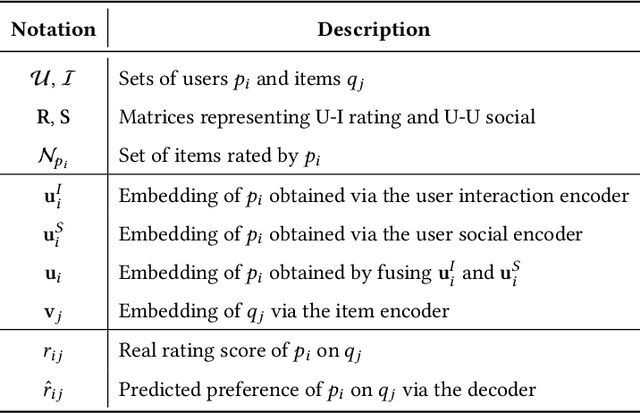
Abstract:Social recommender systems (SocialRS) simultaneously leverage user-to-item interactions as well as user-to-user social relations for the task of generating item recommendations to users. Additionally exploiting social relations is clearly effective in understanding users' tastes due to the effects of homophily and social influence. For this reason, SocialRS has increasingly attracted attention. In particular, with the advance of Graph Neural Networks (GNN), many GNN-based SocialRS methods have been developed recently. Therefore, we conduct a comprehensive and systematic review of the literature on GNN-based SocialRS. In this survey, we first identify 80 papers on GNN-based SocialRS after annotating 2151 papers by following the PRISMA framework (Preferred Reporting Items for Systematic Reviews and Meta-Analysis). Then, we comprehensively review them in terms of their inputs and architectures to propose a novel taxonomy: (1) input taxonomy includes 5 groups of input type notations and 7 groups of input representation notations; (2) architecture taxonomy includes 8 groups of GNN encoder, 2 groups of decoder, and 12 groups of loss function notations. We classify the GNN-based SocialRS methods into several categories as per the taxonomy and describe their details. Furthermore, we summarize the benchmark datasets and metrics widely used to evaluate the GNN-based SocialRS methods. Finally, we conclude this survey by presenting some future research directions.
Linear, or Non-Linear, That is the Question!
Nov 14, 2021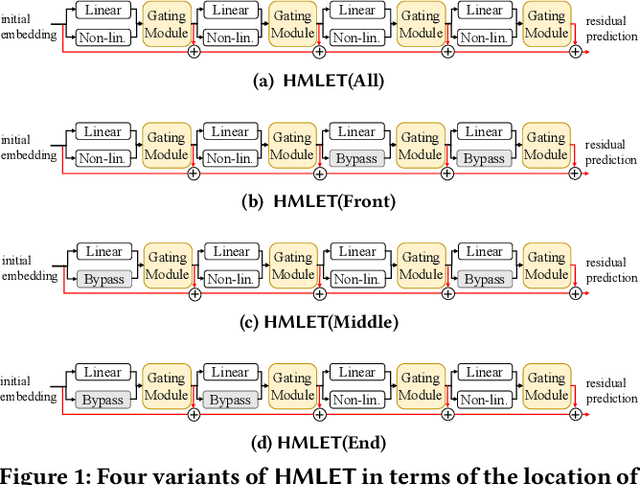
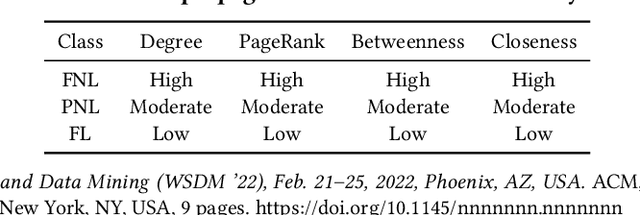

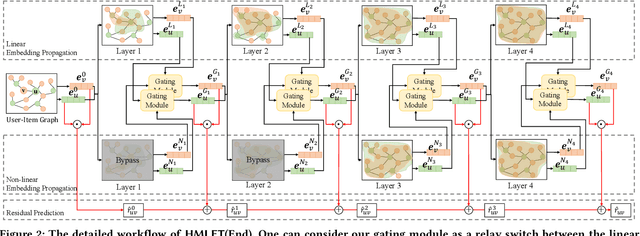
Abstract:There were fierce debates on whether the non-linear embedding propagation of GCNs is appropriate to GCN-based recommender systems. It was recently found that the linear embedding propagation shows better accuracy than the non-linear embedding propagation. Since this phenomenon was discovered especially in recommender systems, it is required that we carefully analyze the linearity and non-linearity issue. In this work, therefore, we revisit the issues of i) which of the linear or non-linear propagation is better and ii) which factors of users/items decide the linearity/non-linearity of the embedding propagation. We propose a novel Hybrid Method of Linear and non-linEar collaborative filTering method (HMLET, pronounced as Hamlet). In our design, there exist both linear and non-linear propagation steps, when processing each user or item node, and our gating module chooses one of them, which results in a hybrid model of the linear and non-linear GCN-based collaborative filtering (CF). The proposed model yields the best accuracy in three public benchmark datasets. Moreover, we classify users/items into the following three classes depending on our gating modules' selections: Full-Non-Linearity (FNL), Partial-Non-Linearity (PNL), and Full-Linearity (FL). We found that there exist strong correlations between nodes' centrality and their class membership, i.e., important user/item nodes exhibit more preferences towards the non-linearity during the propagation steps. To our knowledge, we are the first who designs a hybrid method and reports the correlation between the graph centrality and the linearity/non-linearity of nodes. All HMLET codes and datasets are available at: https://github.com/qbxlvnf11/HMLET.
 Add to Chrome
Add to Chrome Add to Firefox
Add to Firefox Add to Edge
Add to Edge